A Beginner’s Guide to Pest Control Business Start Up
Market research: Is Pest Control business start-up worth the effort?
Before you dive into the Pest Control business start up process, you’d better make sure it’s worth the payoff is worth the buy-in!
Fortunately, the Pest Control industry is thriving. Recent findings by Specialty Consultants Research indicate that the U.S. structural pest control market generated $8.175-billion in service revenue in 2016. And now experts are predicted that this sum will surpass $10-billion next year!
In fact, all Pest Control services are seeing a spike in demand:
Bed bug service revenue increased by 6.6% compared to last year, bringing total service revenue up to $611.2 million;
Mosquito control services were among the fastest-growing segments in 2016, with residential barrier treatments up 12.6% since 2016;
Service revenue from controlling rats and mice in commercial and residential accounts increased to more than $800-million.
You can get the full industry report here. But suffice to say, the time is right to launch your Pest Control business!
Learning the trade
Once you’ve decided that Pest Control business start up is worth the effort, it’s time to start fleshing out your skills and expertise. This step can be a huge headache for self-starters, particularly those with no previous experience in the field. How do you proceed? Should you bite the bullet and fork over tuition for a 4-year Bachelor of Science? How can you be sure that the certification courses you’ve found teach you all you need to know?
Financing your Pest Control business start-up
You have to spend money to make money, right? As is the case with any other business, you’ll need to get your pest control business start-up funded ASAP. But unlike most businesses, pest control business start up won’t cost an arm and a leg.

How to control pests in health care facilities
Health facilities professionals managing hospitals, long-term care facilities, emergency medical care centers and physical or mental rehabilitation facilities, face many challenges to ensure that they meet the highest level of sanitation while caring for sensitive population
Because pests pose a number of health threats through the spread of bacteria and contamination of surfaces, medical supplies and equipment, ensuring that the facility remains pest-free is one of these challenges.
As the size of a facility increases, so do the risk factors for pest infestations — larger kitchens, more food being served, more bathrooms and more visitors, among others. Other factors include the condition of the populations housed within the facilities and the organizational complexity of decision-makers.
Risks of entry
Health facility pest problems can occur because of pests that enter from the immediate surroundings; those that are within the structure; and those that are brought into the facility by visitors or staff via clothing, food, flowers or other items. While it may be difficult to stem the entry of pests by visitors, educating all staff about prevention within the facility can reduce problems.
First and foremost, facilities professionals must implement exclusion steps to stop pests from entering via the immediate surroundings. For example, facility entry doors should be closed at all times and should be designed to reduce or prevent entry of flying pests. Likewise, windows should be properly screened and utility openings properly closed off to prevent entry points.

Cotton Pest Management Guide
The Cotton Pest Management Guide 2020-21 is the industry’s premium resource for insect, mite and weed control, disease prevention, biosecurity and spray application information. The Guide builds on the wealth of knowledge from research the cotton industry has undertaken since the publication first began in the 1980s and is an important tool for growers, agronomists and consultants alike
Importantly, when it comes to protecting the crop, growers are not alone – insects, weeds and diseases do not respect farm boundaries, so it’s important that the industry works together to manage pests.
The Cotton Pest Management Guide is published by and the industry’s joint CottonInfo team and is updated each year to incorporate the latest research and development findings and consistent improvements in industry best practice. This year, we continue our partnership with our fellow key industry organisation,
on the development of the Guide. This partnership involves a review of the Guide by a CCA Technical Review Panel, providing technical expertise to ensure it remains as useful as possible for both growers and consultants.
Pest Control
This guide brings together the varied and multiple skills and activities required of pest control practitioners, including biology, chemistry, architecture, engineering, sales, logistics, legal and accounting, presented with a primary emphasis on pest organisms at its core. This book provides information and tips on all of these aspects and: explores the business of controlling pests (including trends in the industry, pest control tools, and sustainable pest control)
covers biological information on each pest in addition to information on control and management, monitoring and follow-up; focusses particularly on globally significant pests with internationally-applicable use and guidance; and provides practical and hands-on experience, drawing on original case studies
This is a key resource for pest control practitioners, as well as in-house staff of companies or buildings involved in household or urban pest control. It is also a valuable reference for researchers, and sanitation and building managers.
The Landlord and Tenant Guide to Pest Management
Property Managers and Landlords
While routine pest management may be an integral part of maintaining rental property, landlords and property managers should be aware that their use of pesticide is regulated by the State Environmental Conservation Law (ECL Article 33 §33-0905). When landlords and property managers become aware of a pest infestation, the first thought may be to exterminate the pests. However, the Environmental Conservation Law says that a person may only apply pesticides to the individual dwelling unit (e.g., house or apartment) in which they reside, unless they are a certified commercial applicator.
A landlord can treat property that is occupied by a tenant, only if (s)he is a certified commercial pesticide applicator. Pesticide applications should not be done in an occupied dwelling unit by an unlicensed landlord, property manager, or building superintendent. To obtain information on becoming a certified applicator, refer to the section entitled
This requirement applies to the use of any pesticide, including general use products and restricted use pesticides.
Managers and landlords can take steps to minimize the use of pesticides and comply with environmental laws
Inspect the property often. This will help you identify what, where and why pests are active and determine how to fix the problem.
Treat the property. Pesticides should be used only as a last resort. If non-toxic methods fail or are impractical, use a pesticide that is effective for the intended pest and least likely to affect people and pets. Only trained and qualified specialists should handle or apply pesticides.
Monitor and Evaluate the property for pests to ensure that once actions are taken or an area is treated, the pests do not return.
Tenants
The Environmental Conservation Law says that tenants may treat their own living space with a general use pesticide, but may not apply a product in common living areas (e.g. hallways, doorways, or stairwells in multi-unit housing).
If a pesticide is used, always:
Read the label first.
Product labels contain important instructions on proper application and the amount to use. Applying more than the recommended amount is dangerous and illegal, and does not improve results.
Buy only pesticides that have an EPA Registration Number on the label and are in their original container.
Never purchase pesticides from street vendors. They may be dangerous and illegal. Some illegal pesticides appeal to children because they resemble candy or other familiar objects. A child may eat or touch the product and get sick.
Never transfer the contents of a pesticide product into another container.
This can lead to accidental ingestion.
Choose a pesticide that is specific for the pest you have.
If the label indicates that a product should be used outdoors, it should never be used indoors. If a product is designated for crawling insects, it should not be used on flying insects.